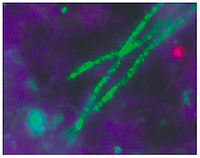Acidobacterias
| Acidobacterias | |||||
|---|---|---|---|---|---|
 Acidobacterium | |||||
| Clasificación científica | |||||
| |||||
| Clase | |||||
| |||||
As acidobacterias (Acidobacteria, Acidobacteriota) son un novo filo introducido recentemente de bacterias, formado por especies diversas fisioloxicamente e moi comúns, especialmente nos solos, pero difíciles de cultivar.[1][2][3]
Os membros deste filo están moi diversificados fisioloxicamente, e algúns (pero non todos) son acidófilos e foron considerados unha nova división en 1997. O nome do filo procede do da primeira especie descrita e non de que sexan todas acidófilas.[4] A primeira especie descrita deste filo foi Acidobacterium capsulatum, descuberta en 1991.[5] Outras especies notables son Holophaga foetida,[6] Geothrix fermentans,[7] Acanthopleuribacter pedis[8] e Bryobacter aggregatus.[9] Como estas bacterias foron descubertas recentemente e na súa gran maioría non foron cultivadas, a ecoloxía e metabolismo destas bacterias aínda está mal comprendido.[2] Porén, estas bacterias poden ser importantes nos ecosistemas, xa que son particularmente abundantes nos solos.[10]
Filoxenia
[editar | editar a fonte]- Véxase tamén: Taxonomía bacteriana.
O cladograma mostra a taxonomía actualmente aceptada do grupo baseada na LPSN (List of Prokaryotic names with Standing in Nomenclature) [11] [12] e a filoxenia está baseada na comparación das secuencias do ARNr 16S do LTP 106 do Proxecto The All-Species Living Tree Project.[13]
| |||||||||||||||||||||||||||||||||||||||||||||||||||||||||||||||||||||||||||||||||||||||||||||||||||||||||||||||||||
Notas:
♣ Especies publicadas no International Journal of Systematic Bacteriology ou no International Journal of Systematic and Evolutionary Microbiology (IJSB/IJSEM) que están en presna.
♠ Estirpes atopadas no NCBI (National Center for Biotechnology Information) pero non na LPSN.
Notas
[editar | editar a fonte]- ↑ Barns SM, Cain EC, Sommerville L, Kuske CR (2007). "Acidobacteria phylum sequences in uranium-contaminated subsurface sediments greatly expand the known diversity within the phylum". Appl. Environ. Microbiol. 73 (9): 3113–6. PMC 1892891. PMID 17337544. doi:10.1128/AEM.02012-06.
- ↑ 2,0 2,1 Quaiser A, Ochsenreiter T, Lanz C; et al. (2003). "Acidobacteria form a coherent but highly diverse group within the bacterial domain: evidence from environmental genomics". Mol. Microbiol. 50 (2): 563–75. PMID 14617179. doi:10.1046/j.1365-2958.2003.03707.x.
- ↑ Rappé MS; Giovannoni SJ (2003). "The uncultured microbial majority". Annual review of microbiology (en inglés) 53. ISSN 0066-4227. PMID 14527284.
- ↑ Kuske CR, Barns SM, Busch JD (1 September 1997). "Diverse uncultivated bacterial groups from soils of the arid southwestern United States that are present in many geographic regions". Appl. Environ. Microbiol. 63 (9): 3614–21. PMC 168668. PMID 9293013.
- ↑ KISHIMOTO (N.), KOSAKO (Y.) and TANO (T.): Acidobacterium capsulatum gen. nov., sp. nov.: an acidophilic chemoorganotrophic bacterium containing menaquinone from acidic mineral environment. Curr. Microbiol., 1991, 22, 1-7.
- ↑ LIESACK (W.), BAK (F.), KREFT (J.U.) and STACKEBRANDT (E.): Holophaga foetida gen. nov., sp. nov., a new, homoacetogenic bacterium degrading methoxylated aromatic compounds. Arch. Microbiol., 1994, 162, 85-90.
- ↑ COATES (J.D.), ELLIS (D.J.), GAW (C.V.) and LOVLEY (D.R.): Geothrix fermentans gen. nov., sp. nov., a novel Fe(III)-reducing bacterium from a hydrocarbon-contaminated aquifer. Int. J. Syst. Bacteriol., 1999, 49, 1615-1622.
- ↑ FUKUNAGA (Y.), KURAHASHI (M.), YANAGI (K.), YOKOTA (A.) and HARAYAMA (S.): Acanthopleuribacter pedis gen. nov., sp. nov., a marine bacterium isolated from a chiton, and description of Acanthopleuribacteraceae fam. nov., Acanthopleuribacterales ord. nov., Holophagaceae fam. nov., Holophagales ord. nov. and Holophagae classis nov. in the phylum 'Acidobacteria'. Int. J. Syst. Evol. Microbiol., 2008, 58, 2597-2601.
- ↑ KULICHEVSKAYA (I.S.), SUZINA (N.E.), LIESACK (W.) and DEDYSH (S.N.): Bryobacter aggregatus gen. nov., sp. nov., a peat-inhabiting, aerobic chemo-organotroph from subdivision 3 of the Acidobacteria. Int. J. Syst. Evol. Microbiol., 2010, 60, 301-306.
- ↑ Eichorst SA, Breznak JA, Schmidt TM (2007). "Isolation and characterization of soil bacteria that define Terriglobus gen. nov., in the phylum Acidobacteria". Appl. Environ. Microbiol. 73 (8): 2708–17. PMC 1855589. PMID 17293520. doi:10.1128/AEM.02140-06.
- ↑ Ver List of Prokaryotic names with Standing in Nomenclature. Datos de J.P. Euzéby. "Acidobacteria". Arquivado dende o orixinal o 27 de xaneiro de 2013. Consultado o 6 xullo 2012.
- ↑ Ver NCBI webpage on Chlorobi Datos de Sayers; et al. "NCBI Taxonomy Browser". National Center for Biotechnology Information. Consultado o 2011-06-05.
- ↑ See the All-Species Living Tree Project [1] Arquivado 19 de xullo de 2012 en Wayback Machine.. Data extracted from the "16S rRNA-based LTP release 106 (full tree)" (PDF). Silva Comprehensive Ribosomal RNA Database. Arquivado dende o orixinal (PDF) o 07 de maio de 2012. Consultado o 6 xullo 2012.
- ↑ Pankratov, T. A.; Kirsanova, L. A.; Kaparullina, E. N.; Kevbrin, V. V. & Dedysh, S. N. (2012-02-01). "Telmatobacter bradus gen. nov., sp. nov., a cellulolytic facultative anaerobe from subdivision 1 of the Acidobacteria, and emended description of Acidobacterium capsulatum Kishimoto et al. 1991". INTERNATIONAL JOURNAL OF SYSTEMATIC AND EVOLUTIONARY MICROBIOLOGY (en inglés) 62 (2): 430–437. ISSN 1466-5026. doi:10.1099/ijs.0.029629-0.
- ↑ Pankratov T.A., Dedysh S.N. Granulicella paludicola gen. nov., sp. nov., G. pectinivorans sp. nov., G. aggregans sp. nov. and G. rosea sp. nov., novel acidophilic, polymer-degrading acidobacteria from Sphagnum peat bogs. IJSEM 2010, V. 60. P. 2951-2959.
